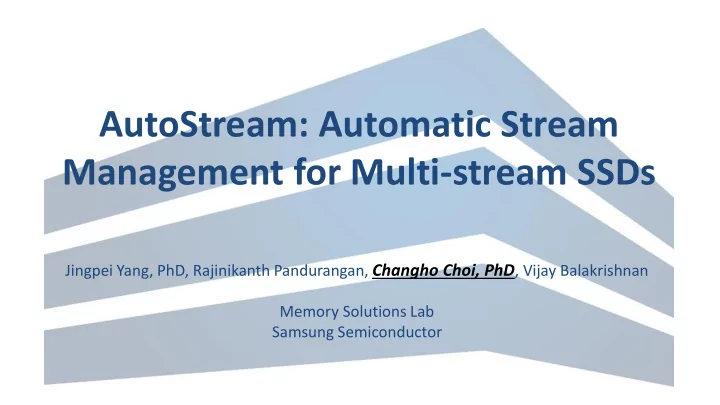

AutoStream: Automatic Stream Management for Multi-stream SSDs Jingpei Yang, PhD, Rajinikanth Pandurangan, Changho Choi, PhD , Vijay Balakrishnan Memory Solutions Lab Samsung Semiconductor
Agenda • SSD NAND flash characteristics • Multi-stream • Autostream: Automatic stream management – Multi-Q – SFR • Performance enhancement • Summary 2
SSD NAND Flash Characteristics • Different IO units – Read/Program: Page, Erase: Block (=multiple of pages) • Erase before program – Out-of-place update • Unavoidable GC overhead – The higher GC overhead, the larger Write Amplification*(= the lower endurance) ∗ 𝑋𝐵𝐺(𝑋𝑠𝑗𝑢𝑓 𝐵𝑛𝑞𝑚𝑗𝑔𝑗𝑑𝑏𝑢𝑗𝑝𝑜 𝐺𝑏𝑑𝑢𝑝𝑠) = 𝑏𝑛𝑝𝑣𝑜𝑢 𝑝𝑔 𝑒𝑏𝑢𝑏 𝑥𝑠𝑗𝑢𝑢𝑓𝑜 𝑢𝑝 𝑂𝐵𝑂𝐸 𝐺𝑚𝑏𝑡ℎ • Limited number of Program/Erase cycles 𝑏𝑛𝑝𝑣𝑜𝑢 𝑝𝑔 𝑒𝑏𝑢𝑏 𝑥𝑠𝑗𝑢𝑢𝑓𝑜 𝑐𝑧 ℎ𝑝𝑡𝑢 To maximize SSD lifetime, need to minimize Write Amplification! 3
Multi-stream: Minimize Write Amplification • Store similar lifetime data into the same erase block and reduce WA (GC overhead) • Provide better endurance and improved performance • Host associates each write operation with a stream • All data associated with a stream is expected to be invalidated at the same time (e.g., updated, trimmed, unmapped, deallocated) • Align NAND block allocation based on application data characteristics(e.g., update frequency) 4
AutoStream: Automatic Stream Management • Multi-stream shows good benefit but requires application and system modification – More challenges in multi-application, multi-tenant environments (e.g., VM or Docker) • AutoStream – Make stream detection independent of applications (e.g., in device driver) – Cluster data into streams according to data update frequency, recency and sequentiality – Minimize stream management overhead in application and systems Multi-stream No app. & Kernel modification required Applications manage Application Application streams Filesystem, block Filesystem, block AutoStream App. & Kernel modification req’d layer, etc. layer, etc. Stream sync overhead Automatic stream Device Driver Device Driver management based on data characteristics 5
AutoStream IO Processing with Minimal Overhead WRITE I/O just one table look up READ I/O bypass AutoStream 6
AutoStream Implementation AutoStream module application Submission queue Write < sLBA, sz > OS kernel < sLBA > File system 2 Multi-Q Block layer queue update < sLBA, sz > 1 AutoStream Device driver controller < sID > 3 TL SFR Write< sLBA, sz, sID > table update 4 Multi-stream SSD 7
Multi-Q Algorithm Basics • Divide a whole SSD space into the same size chunks – 480GB SSD, 1MB chunk size -> 480,000 chunks • Track statistics for each chunk – access time, access count, expiry time, etc. – Expiry time • hottest chunk’s lifetime := current time – last access time • Other chunk’s expiry time:= current time + hottest chunk’s lifetime …… chunk id c c x y z u w c d …… 4 5 6 7 8 9 10 11 12 access time …… 1 2 1 1 1 1 1 3 1 access count Access time 11: Hottest chunk = c Access time 12: Chunk c’s lifetime = 11 – 5 = 6 chunk d expiry time = 18 (12+6) 8
Multi-Q Update (Promotion & Demotion) Demotion Promotion Submission Q e e d b head … c b c a f c a a Multi-Q thread processes Chunk e ’s expiry tail . . . f … each entry time has passed . . . … (recency*) . . . Chunk a ’s access count is bigger … than Q1 ’s access count threshold e a (frequency) … Q2 Q1 Q7 Q8 hot cold 9 * Recency considers the last updated time
SFR - S equentiality F requency R ecency Algorithm AutoStream controller Submission Q <sLBA, sz> … c b c a f SFR thread processes yes no each entry Sequential write? Increase access_cnt sID := Get sID from stream table prev_sID Calculate recency_weight := pow ( 2 , ( curr_time – last_acess_time)/decay_period ) Update prev_sID access_cnt := access_cnt/recency_weight Put sLBA to sID := log(access_cnt) submission queue Stream table update Sequentiality 10 (Frequency, Recency)
Docker Environment Performance Measurement • Running 2 MySQL & 2 Cassandra instances 5 simultaneously WAF 4 Database Size Workload 3 39% MySQL TPC-C: 30 42% 800 warehouse TPC-C connection 2 Cassandra 1KB record, 100 1 r/w: 50/50 -Stress million entries 0 legacy SFR MQ Cassandra average TPS MySQL average tpmC 6% 23500 1200 144% 129% 23000 1000 2% 800 22500 600 22000 400 21500 200 21000 0 11 legacy SFR MQ legacy SFR MQ
Summary • AutoStream – With no application and system modification, improve SSD lifetime and performance • AutoStream with minimal overhead – Works well under different workloads for diverse applications on various system environments – Up to 60% WAF reduction – Up to 237% performance improvement • Future work – Optimize resource utilization and performance to fit into devices 12
Recommend
More recommend